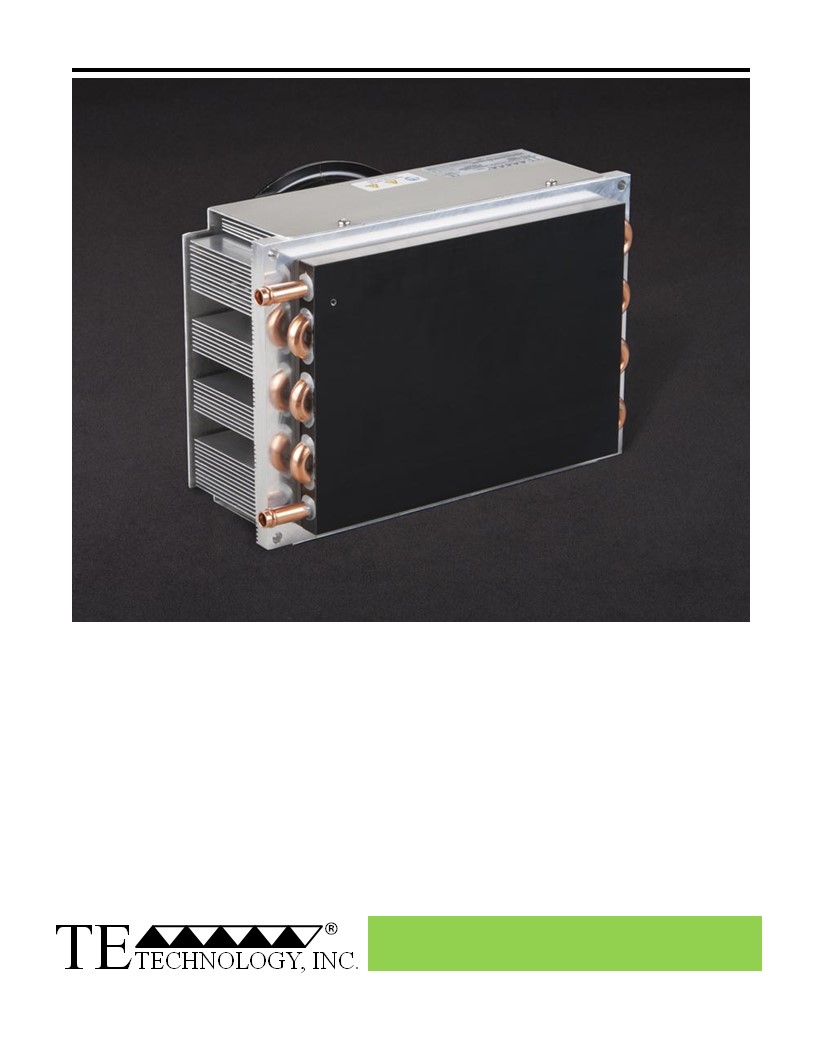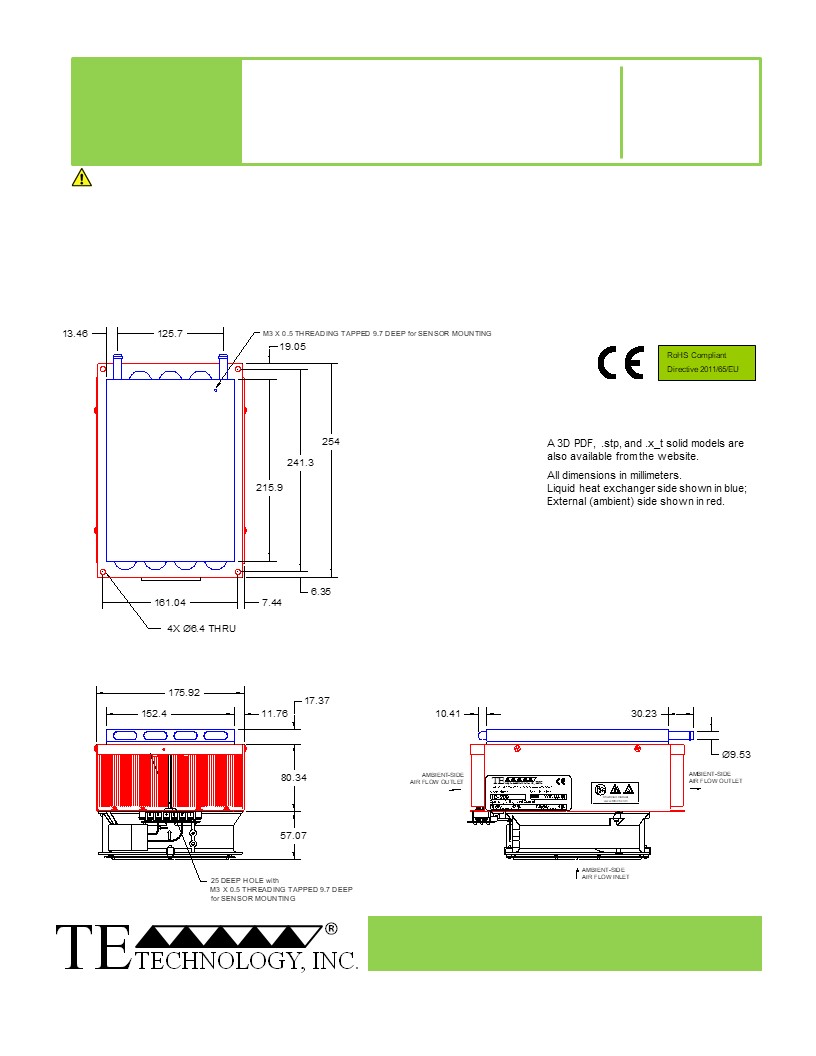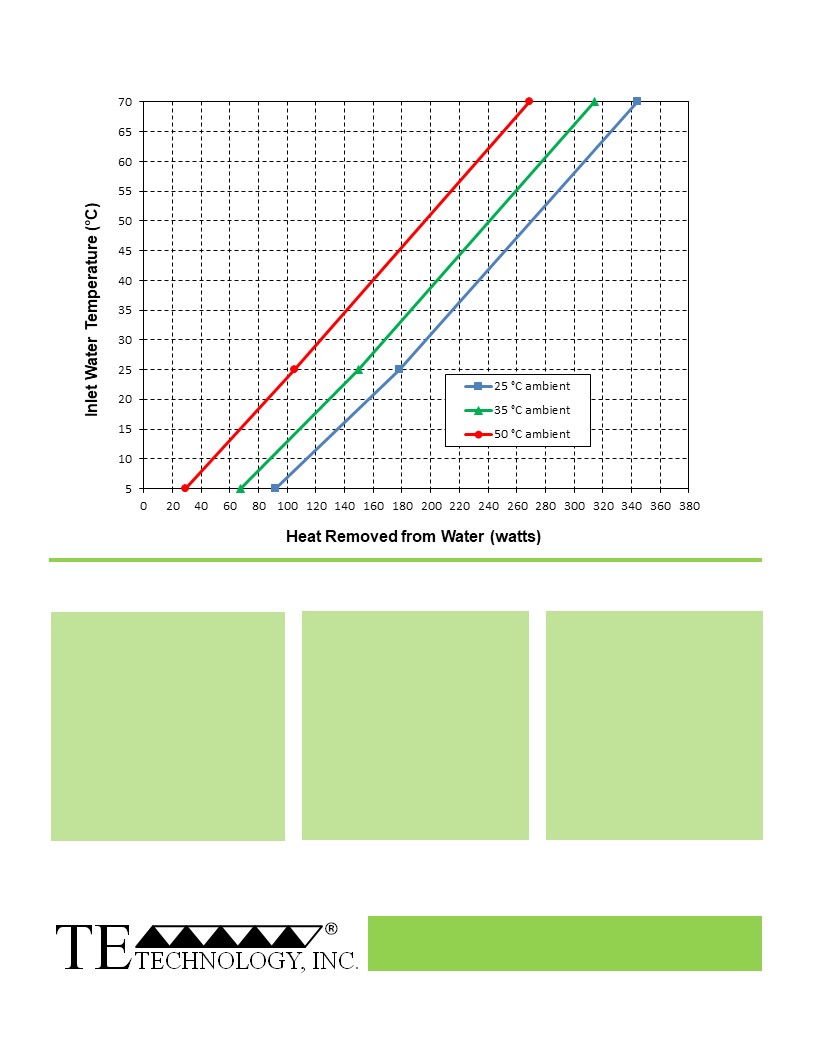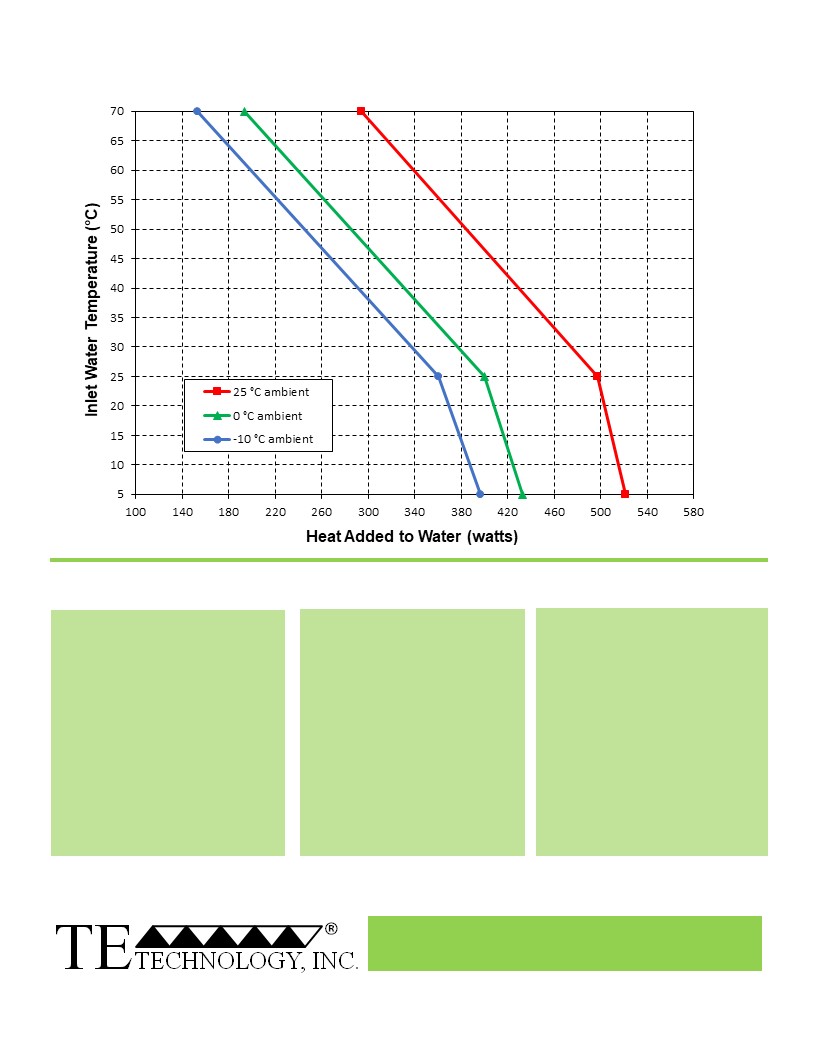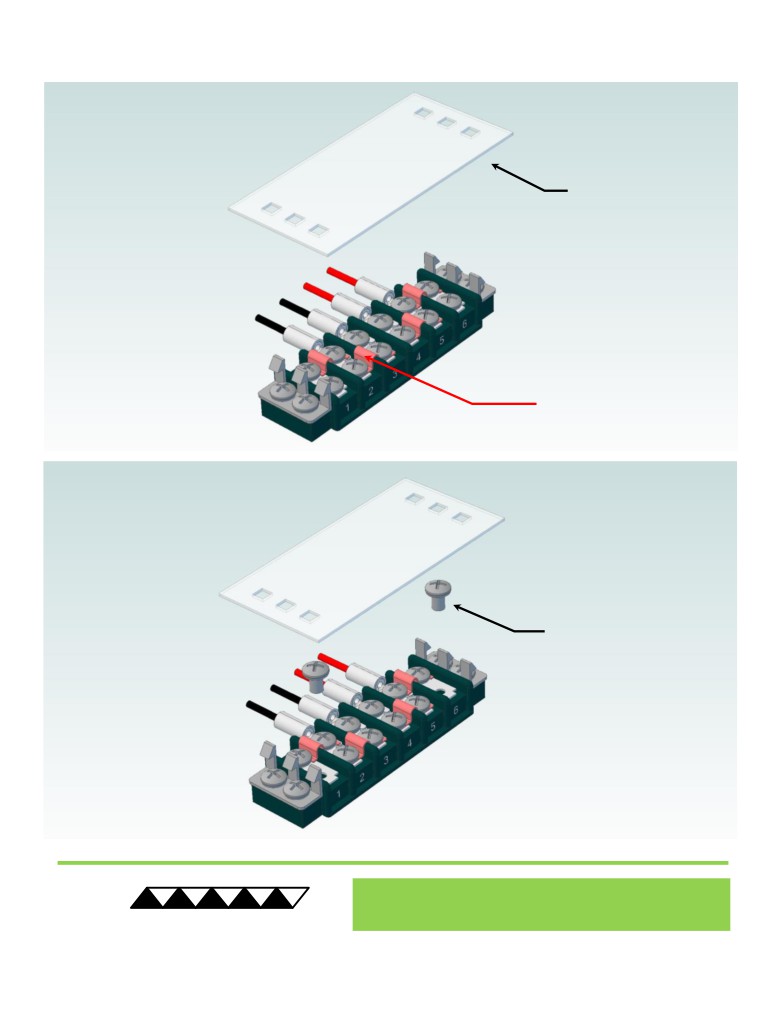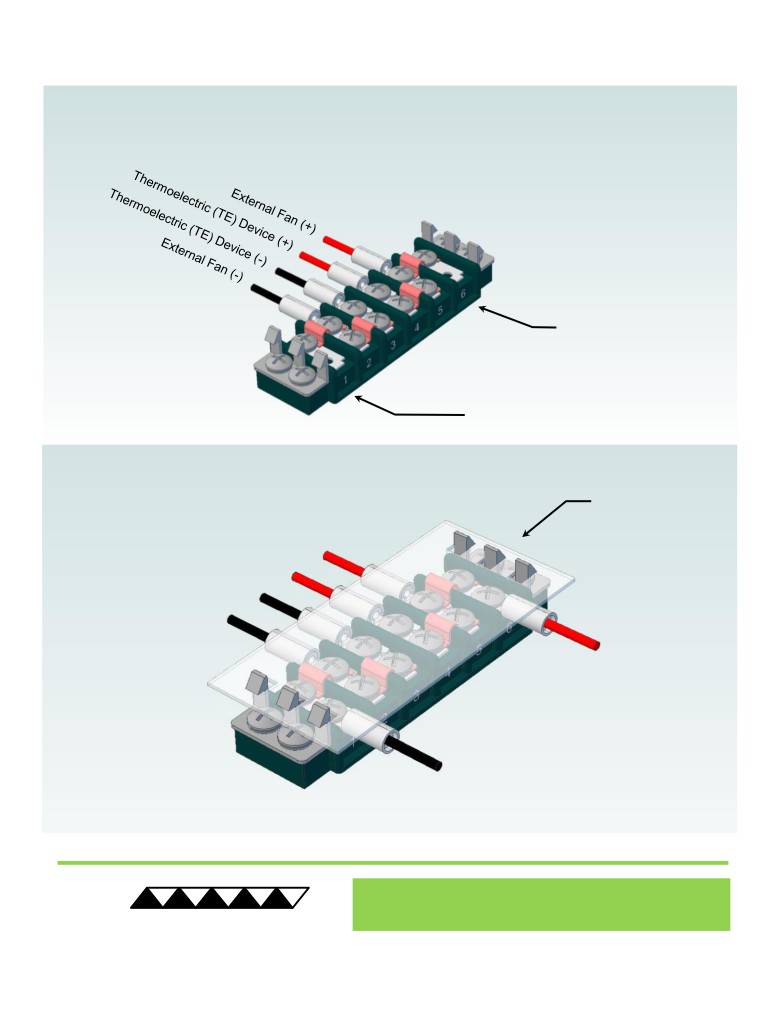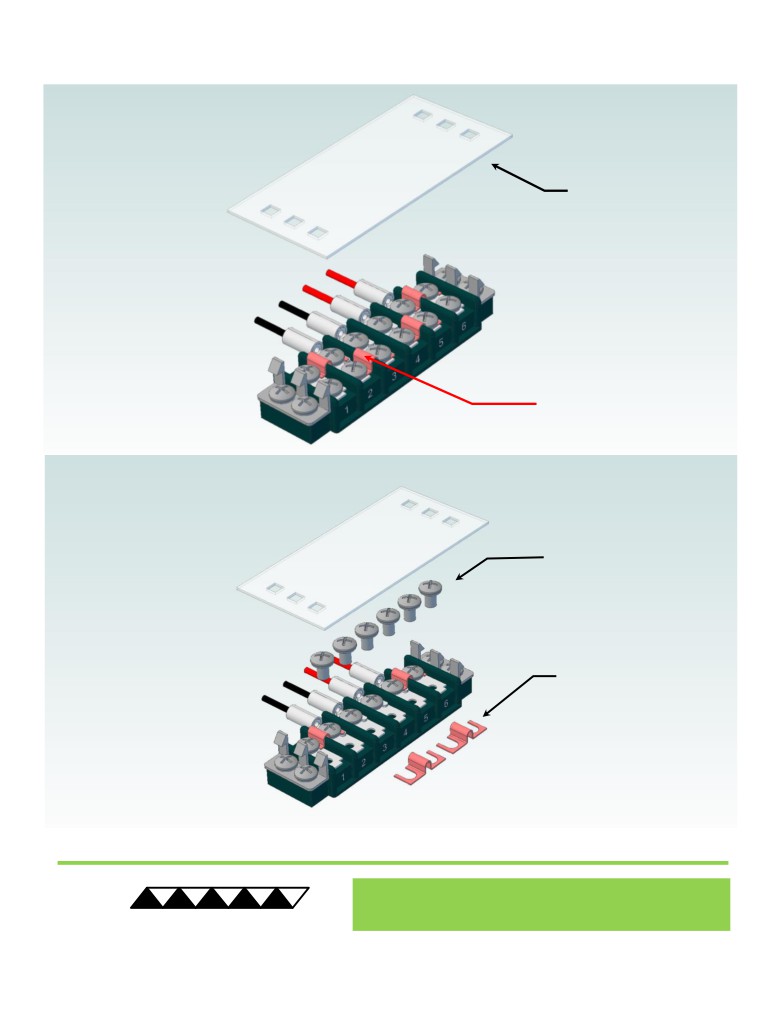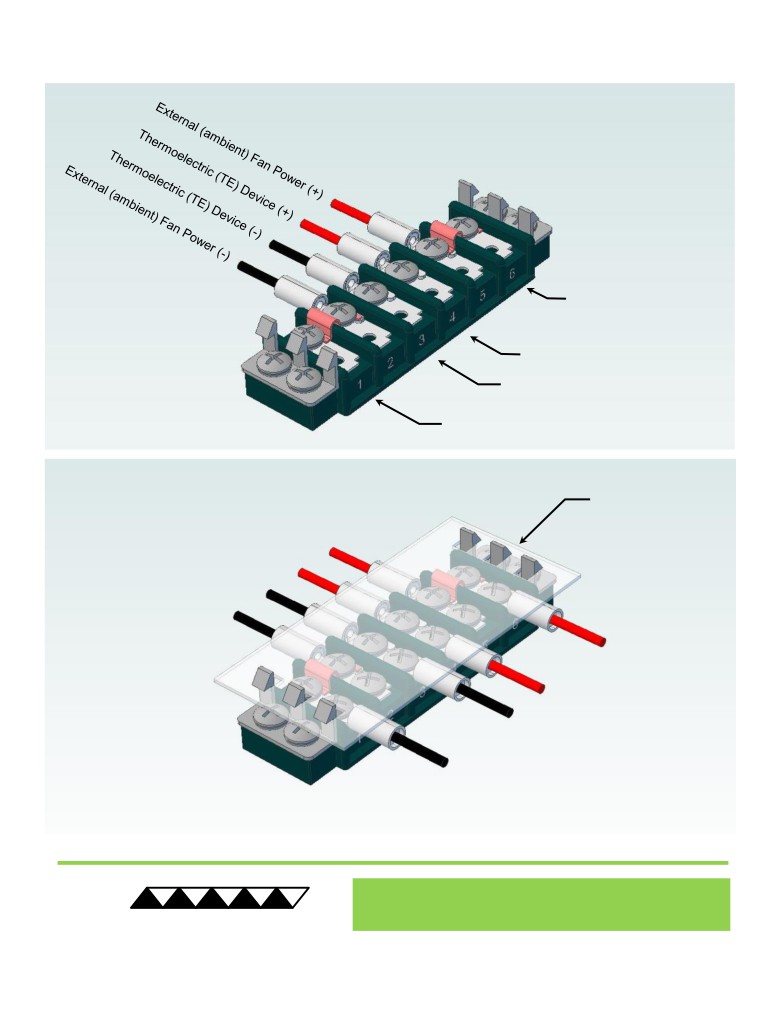LC-200 Peltier-Thermoelectric Liquid Cooler
• A high-density bonded-fin heat sink and an eight-pass liquid exchanger give high
cooling capacity in a relatively small size.
• Useful in medical products, recirculation chillers, laser diode coolers, temperature
baths, laboratory instruments, etc.
• The cooler can easily be customized for production-sized orders to meet your exact
requirements.
• For production sized orders, the cooler may be customized with swirl inserts in the
liquid loops to improve heat transfer at low flow rates.
• Threaded hole located in liquid exchanger provides for easy attachment of a
temperature sensor.
• CE marked, RoHS compliant.
Expert Engineering, Precision Manufacturing:
Quality Thermal Solutions Delivered
NOTE: All specifications are subject to change without notice.
© 2019 TE Technology, Inc.
LC-200 15-JUN-2022 Page 1 of 8
Thermoelectric (TE) Power (typical)1 :
24 VDC at 14.1 A
NEMA Rating: NA
Thermoelectric (TE) Power (maximum)2 :
24 VDC at 17.3 A
LC-200
External (ambient) Fan Power:
24 VDC at 1.0 A
Specifications
Weight (kg):
5.8
External (ambient) Fan Noise:
55 dBA
Performance is based on unrestricted air flow to fan and
from air-flow outlets and 1.6 L/min water flow rate through
the liquid heat exchanger. Do not operate if the ambient,
information before purchasing or using this product.
liquid, heat sink, or liquid heat exchanger temperatures
exceed 70 °C. Do not operate at air temperatures below
-20 °C. Do not freeze the liquid. Do not exceed 205 kPa
water pressure.
1Current, at steady state, is rated at +25 °C ambient, +25 °C inlet water, maximum heat removal. At 5 °C inlet, the typical steady-state current is 13.9 A.
2Current, at steady-state operation under-worst case conditions, is rated at -10 °C ambient, +70 °C inlet, maximum heat removal.
Expert Engineering, Precision Manufacturing:
Quality Thermal Solutions Delivered
NOTE: All specifications are subject to change without notice.
© 2019 TE Technology, Inc.
LC-200 15-JUN-2022 Page 2 of 8
LC-200 Cooling Performance Graph
(removing heat from water, flowing at 1.6 L/min)
How to use the Performance Graph:
1. Select Performance Line
2. Select Enclosure Temperature
3. Determine Cooling Capacity
The diagonal lines represent cooling
Draw a horizontal line on the graph
The maximum amount of heat
performance at the indicated ambient
corresponding to the desired inlet
that the cooler can remove from
air temperature (inlet temperature on
water temperature until it intersects
the water is determined by the
the ambient-side fan). If the cooler is
with the performance line
intersection point (determined in
to operate at a different ambient,
corresponding to the ambient
the previous step). The cooler will
then you must sketch in a new
temperature at which the cooler is to
be able to maintain the desired
performance line. This can be drawn
operate.
water temperature if the cooling
parallel to one of the existing lines,
capacity exceeds the heat load. If
using the distance between the
the heat load exceeds the cooling
existing lines as a scale to properly
capacity then a higher capacity
locate the new line.
cooler will be needed.
Example: You need to maintain the water at 25 °C while in a 25 °C ambient. The cooler can remove a maximum of
approximately 178 W of heat from the water. If the heat load (internally generated heat plus the heat gain through
insulation, solar, vapor condensation, etc.) in the enclosure exceeds this, you would need more coolers and/or a larger
cooler.
Expert Engineering, Precision Manufacturing:
Quality Thermal Solutions Delivered
NOTE: All specifications are subject to change without notice.
© 2019 TE Technology, Inc.
LC-200 15-JUN-2022 Page 3 of 8
LC-200 Heating Performance Graph
(adding heat to water, flowing at 1.6 L/min)
How to use the Performance Graph:
1. Select Performance Line
2. Select Enclosure Temperature
3. Determine Heating Capacity
The diagonal lines represent heating
Draw a horizontal line on the graph
The maximum amount of heat that
performance at the indicated ambient
corresponding to the desired inlet
the cooler can add to the water is
air temperature (inlet temperature on
water temperature of the enclosure.
determined by the intersection point
the ambient-side fan). If the cooler is
Make the line intersect with the
(determined in previous step). If the
to operate at a different ambient,
performance line corresponding to
heat added to the water (including
then you must sketch in a new
the ambient temperature at which
heat generated by equipment inside)
performance line. This can be drawn
the cooler is to operate.
is greater than the enclosure’s heat
parallel to one of the existing lines,
loss, then the cooler will be able to
using the distance between the
heat to the desired temperature. A
existing lines as a scale to properly
higher capacity cooler will be
locate the new line.
needed if the total heat added is less
than the enclosure’s heat loss.
Example: You need to maintain the water at 30 °C while in a -10 °C ambient. The cooler can add a maximum of
approximately 337 W of heat to the water. If the heat dissipation from the enclosure exceeds this (plus anything else
generating heat), you would need more coolers and/or a larger cooler.
Expert Engineering, Precision Manufacturing:
Quality Thermal Solutions Delivered
NOTE: All specifications are subject to change without notice.
© 2019 TE Technology, Inc.
LC-200 26-DEC-2019 Page 4 of 8
Terminal Block Configuration for Continuous Operation at Full Power
As-Shipped Configuration 1 of 2
1
REMOVE TERMINAL
BLOCK COVER
FOUR ELECTRICAL
JUMPERS INSTALLED
(ORIGINAL
CONFIGURATION)
2
LOOSEN TWO SCREWS
KEEP JUMPERS INSTALLED
® Expert Engineering, Precision Manufacturing:
Quality Thermal Solutions Delivered
TE
TECHNOLOGY, INC.
• cool@tetech.com • 231-929-3966 • 1590 Keane Drive • Traverse City, MI 49696
NOTE: All specifications are subject to change without notice.
© 2018 TE Technology, Inc.
LC-200 26-DEC-2019 Page 5 of 8
Terminal Block Configuration for Continuous Operation at Full Power
2 of 2
3
Power supply (+) Red Wire
to POSITION 6
Power supply (-) Black Wire
to POSITION 1
INSTALL WIRES,
4
TIGHTEN SCREWS
TO 1.0 N-M, AND
REPLACE COVER
® Expert Engineering, Precision Manufacturing:
Quality Thermal Solutions Delivered
TE
TECHNOLOGY, INC.
NOTE: All specifications are subject to change without notice.
© 2018 TE Technology, Inc.
LC-200 26-DEC-2019 Page 6 of 8
Terminal Block Configuration for Operation with Temperature Controller
1 of 2
1
REMOVE TERMINAL
BLOCK COVER
FOUR ELECTRICAL
JUMPERS INSTALLED
(ORIGINAL
CONFIGURATION)
2
LOOSEN SIX SCREWS
REMOVE TWO
ELECTRICAL JUMPERS
FROM 2-3 AND 4-5
® Expert Engineering, Precision Manufacturing:
Quality Thermal Solutions Delivered
TE
TECHNOLOGY, INC.
NOTE: All specifications are subject to change without notice.
© 2018 TE Technology, Inc.
LC-200 26-DEC-2019 Page 7 of 8
Terminal Block Configuration for Operation with Temperature Controller
2 of 2
3
Power supply (+) Red Wire
to POSITION 6
Temperature Controller (+) Red Wire
to POSITION 4
Temperature Controller (-) Black Wire
To POSITION 3
Power supply (-) Black Wire
to POSITION 1
INSTALL WIRES,
4
TIGHTEN SCREWS
TO 1.0 N-M, AND
REPLACE COVER
® Expert Engineering, Precision Manufacturing:
Quality Thermal Solutions Delivered
TE
TECHNOLOGY, INC.
NOTE: All specifications are subject to change without notice.
© 2018 TE Technology, Inc.
LC-200 26-DEC-2019 Page 8 of 8
